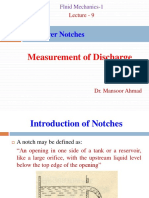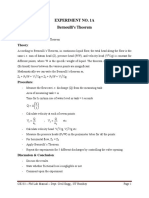100%(1)100% found this document useful (1 vote)
292 viewsFlow Over Notches
Uploaded by
shahryarahmadCopyright
© Attribution Non-Commercial (BY-NC)
Available Formats
Download as PDF or read online on Scribd
100%(1)100% found this document useful (1 vote)
292 viewsFlow Over Notches
Uploaded by
shahryarahmadCopyright
© Attribution Non-Commercial (BY-NC)
Available Formats
Download as PDF or read online on Scribd
You are on page 1/ 4
1
Flow Over Notches
1. Introduction. 2°Types of Notches. 3. Discharge over a Rectangular Notch. 4. Discharge over
a Triangular Notch. _ 5. Advantages of a Trinagular Notch over a Rectangular Notch. 6. Discharge over a |
Trapezoidal Notch. 7. Discharge over a Stepped Notch. 8. Time of Emprying a Tank over a Rectangular
Notch. 9. Time of Emptying a Tank over a Triangular Notch. 10. Effect on the Discharge over a Notch, due”
to an Error in the Measurement of Head. 11. Effect on the Discharge over a Rectangular Notch, due to an
Evrorin the Méasurement of Head. 12. Effect on the Discharge over a Triangular Notch due 10 an Error in
the Measurement of Head.
er een RASA
11-1 Introduction
‘A notch may be defined as-an opening in one side of a tank or a reservo
with the upstream liquid level below the top edge of the opening as shown in Fig. 11-1.
Since the top edge of the notch above the liquid level serves no
purpose, therefore a notch may have only the bottom edge and sides.
‘The bottom edge, over which the liquid flows, is known as sill or
crest of the notch and the sheet of liquid flowing over a notch (or a
weir) is known as nappe or vein. A notch is, usually, made of a
metallic plate and is used to measure the discharge of liquids.
‘11-2. Types of Notches Fig. 11-1. A Notch? —
There are many types of notches, depending upon their shapes. But the following are imp
from the subject point of view : 4
1, Rectangular notch,
2.° Triangular notch,
3. Trapezoidal notch, and : :
4. Stepped notch.
In this chapter, we shall discuss the discharge or the phenomenon associated with di
cover all thése notches one-by-one. 3
11-3 Discharge over a Rectangular Notch
Consider a rectangular notch in one side of a tank over which water is flowing as s
Fig. 11-2. ‘ '
Let ; H_ = Height of water above sill of the notch,”
b = Width or length of the notch, and
¢,
Flow Over Notches 195
Fig. 11-2. Rectangular notch,
Let us consider a horizontal strip of water of thickness dh at a depth of 4 from the water level
ss shown in Fig. 11-2.
- ., Area of the strip = b.dh —.
We know that the theoretical velocity of water through the strip
ae. = /2gh +++ (ii)
snd discharge through the strip, :
dq = C, x Area of strip x Theoretical velocity
=C,. bdh J2gh + iii)
The total discharge, over the whole notch, may be found out by integrating the above equation
within the limits 0 and H.
H
= Q if Cy.b.dh J2gh
oO
a
= Cy.b.dh 2g J h'? dh
0
4
1?
= Cy.b 2g >
2 bo
= cub a [wryt
2
wren b 2g (Hy?
Note : Sometimes, the limits of integration, in the above equation, are from H, to HY, (ce, the liquid
lvel is ata height of H, above the top of the notch and H, above the bottom of the notch, instead of 0 ta H.
Then the discharge over such a notch will be given by the equation : a
- = 2 Cd.b Je (43°? 42%)
Example 11-1. 4 rectangular notch 0.5 metres wide has a constant head of 400 mm. Find the
discharge over the notch in litres per second, if the coefficient of discharge for the notch is 0-62.
Solution. Given : b = 0-5 m; H = 400 mm = 0-4 mand C, = 0-62.
‘We know that the discharge over the rectangular notch,
Q= z Ca.b f2g (HY? mis
196 Flow Over Notches
2 -
e-3 0:62 * 0:5 f2x9-81 (0-4)? m’/s
= 0-915 x 0-253 = 0-231 m/s = 231 litres/s Ans.
Example 11-2. 4 rectangular notch has a discharge of 21-5 cubic metres per minute, when
the head of water is half the length of the notch. Find the length of the notch. Assume Cy = 0-6.
Solution. Given : Q = 21-5 m/min = 21-5/60 = 0-358 m/s; H = b/2 = 0-5 b and C,.= 0-6. 7
We know that the discharge over the rectangular notch (Q),
2
0-358 = Cy .b J2g (HY?
an
- = 0-6 x b 2x9 81 G) = 0-626 b*?
A p82 = 0-358/0:626=0:572 or b= 08m Ans.
11-4 Discharge over a Triangular No‘ch
A triangular notch is also called a V-notch. Consider a triangular notch, in one side of the
tank, over which water is flowing as shown in Fig. 11:3.
Let H = Height of the liquid above
: the apex of the notch,
® = Angle of the notch, and
C, = Coefficient of discharge.
From the geometry of the figure, we find that the width
of the notch at the water surface
:
= 2H tan >
Notch
0
‘Area of the strip = 2 (H=A) tan >. dh
2 Fig. 11-3. Triangular notch
We know that the theoretical velocity of water through the strip
= 2h
and discharge over the notch,
dq = C, * Area of strip * Theoretical velocity
8
=C,*2(H-W) tan 5 dh y2eh By
” ‘The total discharge, over the whole notch, may be found out by integrating the above equi
within the limits 0 and H.
H
: 8
o- Jou.2-) tan 5 dh aah
°
= 2C, \28 tan $ (H-h) fh dh
tz ots
= 8 FE iia 2 yi
= 2C, 2K tan 5 [can'? - ny?) ah
Flow Over Noiches 197
oe] HA? 45
@ = 2C, V2@ tan > 7
2 25
= 3 Cy J2g tan $ x A?
Cor. If @ = 90°, C,= 0-6 and g = 9:81 m/s?, then Q =1-417 H?
11-5 Advantages of a Triangular Notch over a Rectangular Notch
Following are the advantages of a triangular notch over a rectangular notch :
1, Only one reading i.e., head (H) is required to be taken for the measurement of discharge
in a given triangular notch.
2. If, in a triangular notch the angle of the notch ie, @ = 90°, the formula becomes very
simple (i.e., Q = 1.417 H°2) to remember.
3. A traingular notch givés more accurate results for low discharges than a rectangular
notch,
4. The same triangular notch can measure a wide range of flows accurately.
Example 11-3. 4 right-angled V-notch was used to measure the discharge of a centrifugal
pump. If the depth of water at V-notch is 200 mm, calculate the discharge over the notch in litres per
minute. Assume coefficient of discharge as 0-62.
Solution. Given 6 = 90°; H = 200 mm = 0.2 m and C, = 0-62.
We know that the discharge over the triangular noch,
0 = 2c, fi an xn”
if, ax 0-62 x J2* 9-81 tan 45°x (0-2)>? m/s
= 1-465 x 0-018 = 0-026 m/s
= 26 litres/s = 1560 litres/min Ans.
Example 11-4. During an experiment in a laboratory, 280 litres of water flowing over a
right-angled notch was collected in one minute. If the head of water over the sill is 100 mm,
calculate the coefficient of discharge of the notch. :
Solution. Given : Q = 280 litres/min = 0-28 m/min = 0.0047 m'/s and H = 100 mm = 0-1 m.
We know that the discharge over the triangular notch (Q),
; 0.0047 = * C, ¥2g tan $ x Ho?
: -3c, 2 981 tan 45° x (0-15? =0 0075C,
3 C, = 0.0047 / 0.0075 = 0-627 Ans.
Example 11:5. 4 rectangular channel of 1-5 metre width is used to carry 0-2 cubic metre of
ver The rate of flow is measured by placing a 90° V-notch weir. If the maximum depth of water is
10 exceed 1-2 metres, find the positiori of the apex of the notch from. the bed of the channel.
ibume C, = 0.6.
eS
Solution. Given : ‘Width of rectangi r notch (b) = 1-5 m; Q=0:2 m'/s; @ = 90° and C,=0.6.
Let H = Height of water above the apex of notch.
You might also like
- Lab Manual 2 Rectangular and Triangular NotchesNo ratings yetLab Manual 2 Rectangular and Triangular Notches8 pages
- To Estimate Manning's Roughness Coefficient (N) and Chezy's Coefficient (C) For Open Channel Flow.No ratings yetTo Estimate Manning's Roughness Coefficient (N) and Chezy's Coefficient (C) For Open Channel Flow.6 pages
- Design 3, Estimation of The Hydro Power Potential For A Given Water Power Development SchemeNo ratings yetDesign 3, Estimation of The Hydro Power Potential For A Given Water Power Development Scheme10 pages
- CHE241 - Lab Report Solteq Flow Over Wei PDF100% (1)CHE241 - Lab Report Solteq Flow Over Wei PDF22 pages
- Fluid Mechanics Lab Laboratory Manual: Dev Bhoomi Institute Chakrata Road, Navgaoun Manduwala, Uttarakhand100% (1)Fluid Mechanics Lab Laboratory Manual: Dev Bhoomi Institute Chakrata Road, Navgaoun Manduwala, Uttarakhand29 pages
- CIV 2213 - Fluid Mechanics II At-Home Test No. 1 Date & Start Time: Time AllowedNo ratings yetCIV 2213 - Fluid Mechanics II At-Home Test No. 1 Date & Start Time: Time Allowed3 pages
- Experiment 1 - Calibrating The Venturi Meter and Orifice MeterNo ratings yetExperiment 1 - Calibrating The Venturi Meter and Orifice Meter4 pages
- TUTORIAL3 Series-Paralel-Branched Pipe SystemNo ratings yetTUTORIAL3 Series-Paralel-Branched Pipe System5 pages
- Hydraulic Laboratory Civil Engineering Department Sultan Azlan Shah Polytechnic75% (4)Hydraulic Laboratory Civil Engineering Department Sultan Azlan Shah Polytechnic12 pages
- Tar and Bituminous Materials - Methods For Test - Determination of Solubility in TrichloroethyleneNo ratings yetTar and Bituminous Materials - Methods For Test - Determination of Solubility in Trichloroethylene10 pages
- Lec-2specific Enrgy-Rapidly Varying Flow PDF100% (1)Lec-2specific Enrgy-Rapidly Varying Flow PDF133 pages
- Determination Discharge and Mean VelocityNo ratings yetDetermination Discharge and Mean Velocity11 pages
- Experiment #4 Discharge Through An Orifice MeterNo ratings yetExperiment #4 Discharge Through An Orifice Meter6 pages
- Lab-2: Flow Over A Weir Objectives: Water Resources Engineering Jagadish Torlapati, PHD Spring 2017No ratings yetLab-2: Flow Over A Weir Objectives: Water Resources Engineering Jagadish Torlapati, PHD Spring 20174 pages
- Operation and Safety of Dams ... ..Dr. Ammar H. KamelNo ratings yetOperation and Safety of Dams ... ..Dr. Ammar H. Kamel9 pages
- Moisture-Density Relationship (Standard Proctor Test) : I. ObjectivesNo ratings yetMoisture-Density Relationship (Standard Proctor Test) : I. Objectives6 pages
- Calibration of Contracted Rectangular WeirNo ratings yetCalibration of Contracted Rectangular Weir9 pages
- Experiment 2, Flow Over A Broad Crested WeirNo ratings yetExperiment 2, Flow Over A Broad Crested Weir4 pages
- CE-2101 Fluid Mechanics: Flow Through Orifices & Notches100% (1)CE-2101 Fluid Mechanics: Flow Through Orifices & Notches45 pages
- Consturction and Analysis of Notches and WeirsNo ratings yetConsturction and Analysis of Notches and Weirs6 pages
- To Estimate Manning's Roughness Coefficient (N) and Chezy's Coefficient (C) For Open Channel Flow.To Estimate Manning's Roughness Coefficient (N) and Chezy's Coefficient (C) For Open Channel Flow.
- Design 3, Estimation of The Hydro Power Potential For A Given Water Power Development SchemeDesign 3, Estimation of The Hydro Power Potential For A Given Water Power Development Scheme
- Fluid Mechanics Lab Laboratory Manual: Dev Bhoomi Institute Chakrata Road, Navgaoun Manduwala, UttarakhandFluid Mechanics Lab Laboratory Manual: Dev Bhoomi Institute Chakrata Road, Navgaoun Manduwala, Uttarakhand
- CIV 2213 - Fluid Mechanics II At-Home Test No. 1 Date & Start Time: Time AllowedCIV 2213 - Fluid Mechanics II At-Home Test No. 1 Date & Start Time: Time Allowed
- Experiment 1 - Calibrating The Venturi Meter and Orifice MeterExperiment 1 - Calibrating The Venturi Meter and Orifice Meter
- Hydraulic Laboratory Civil Engineering Department Sultan Azlan Shah PolytechnicHydraulic Laboratory Civil Engineering Department Sultan Azlan Shah Polytechnic
- Tar and Bituminous Materials - Methods For Test - Determination of Solubility in TrichloroethyleneTar and Bituminous Materials - Methods For Test - Determination of Solubility in Trichloroethylene
- Lab-2: Flow Over A Weir Objectives: Water Resources Engineering Jagadish Torlapati, PHD Spring 2017Lab-2: Flow Over A Weir Objectives: Water Resources Engineering Jagadish Torlapati, PHD Spring 2017
- Operation and Safety of Dams ... ..Dr. Ammar H. KamelOperation and Safety of Dams ... ..Dr. Ammar H. Kamel
- Moisture-Density Relationship (Standard Proctor Test) : I. ObjectivesMoisture-Density Relationship (Standard Proctor Test) : I. Objectives
- CE-2101 Fluid Mechanics: Flow Through Orifices & NotchesCE-2101 Fluid Mechanics: Flow Through Orifices & Notches


























































